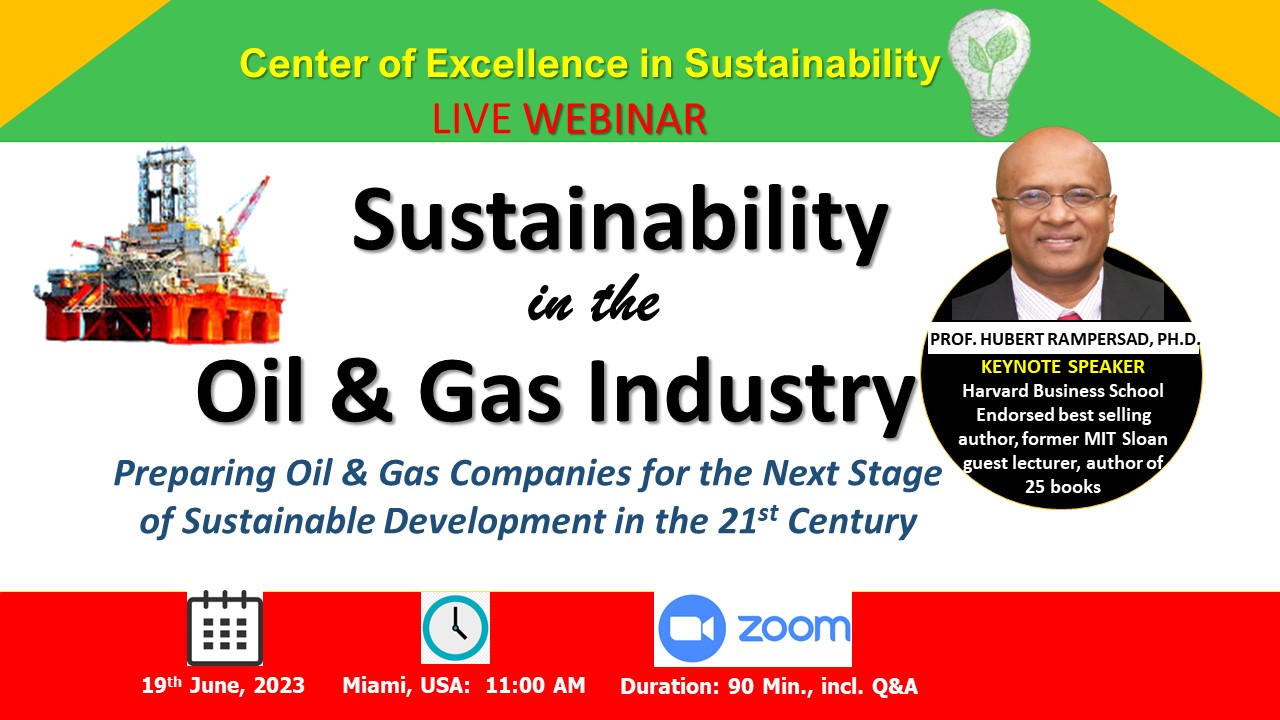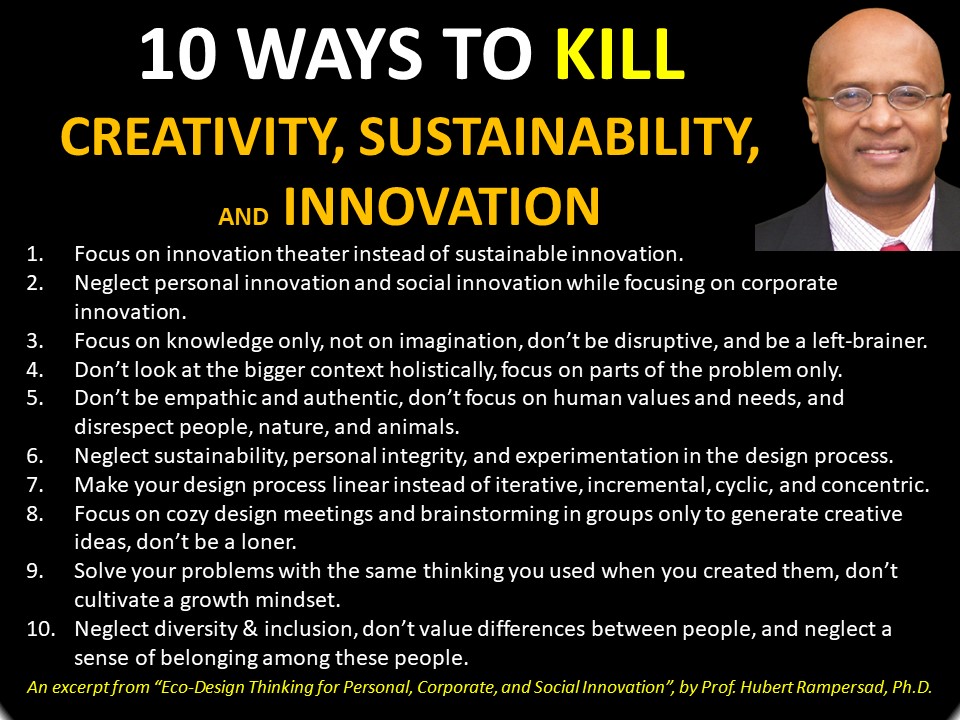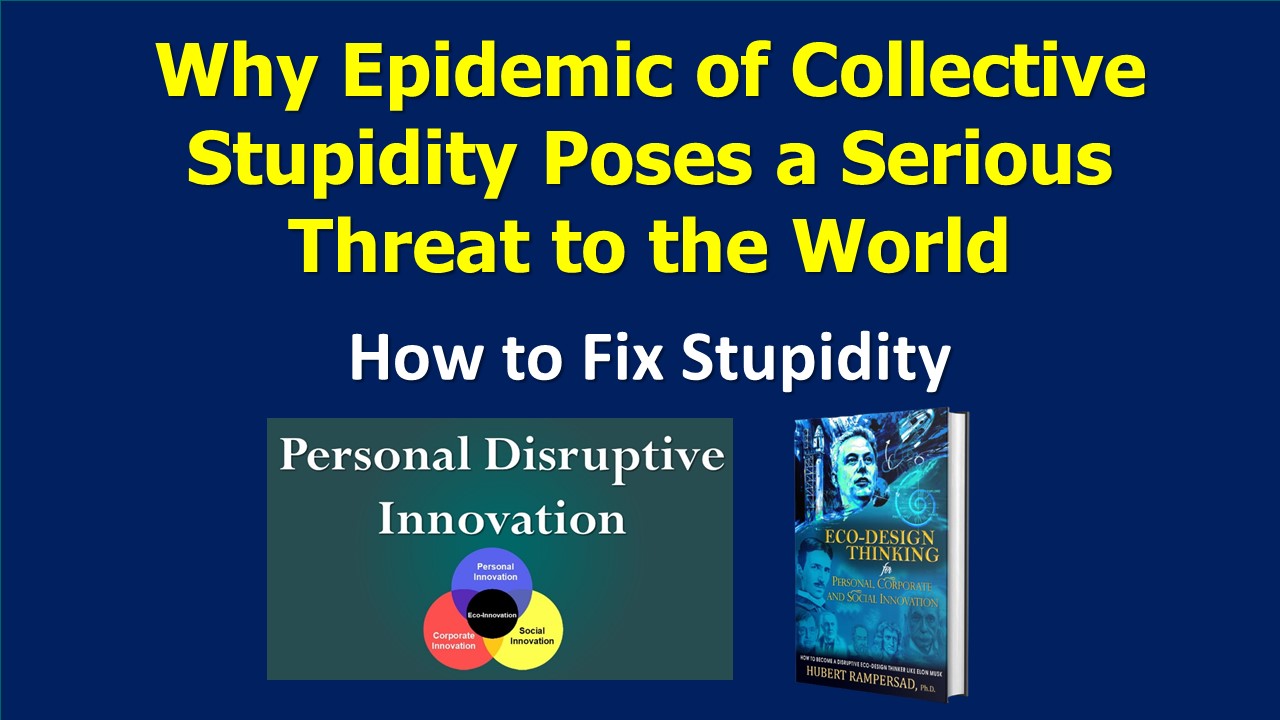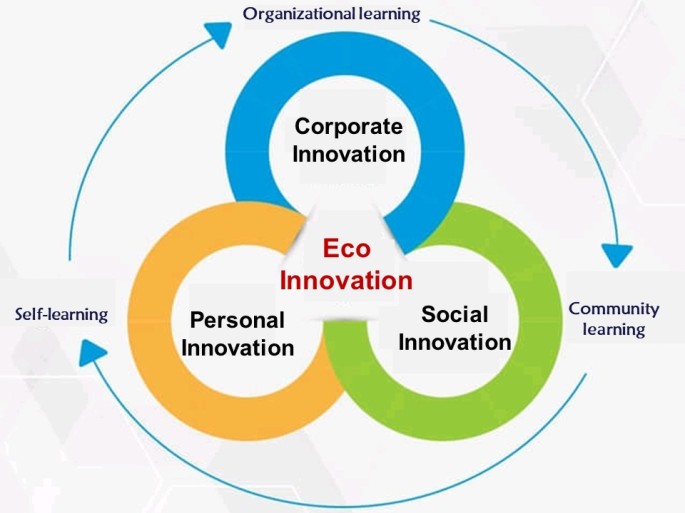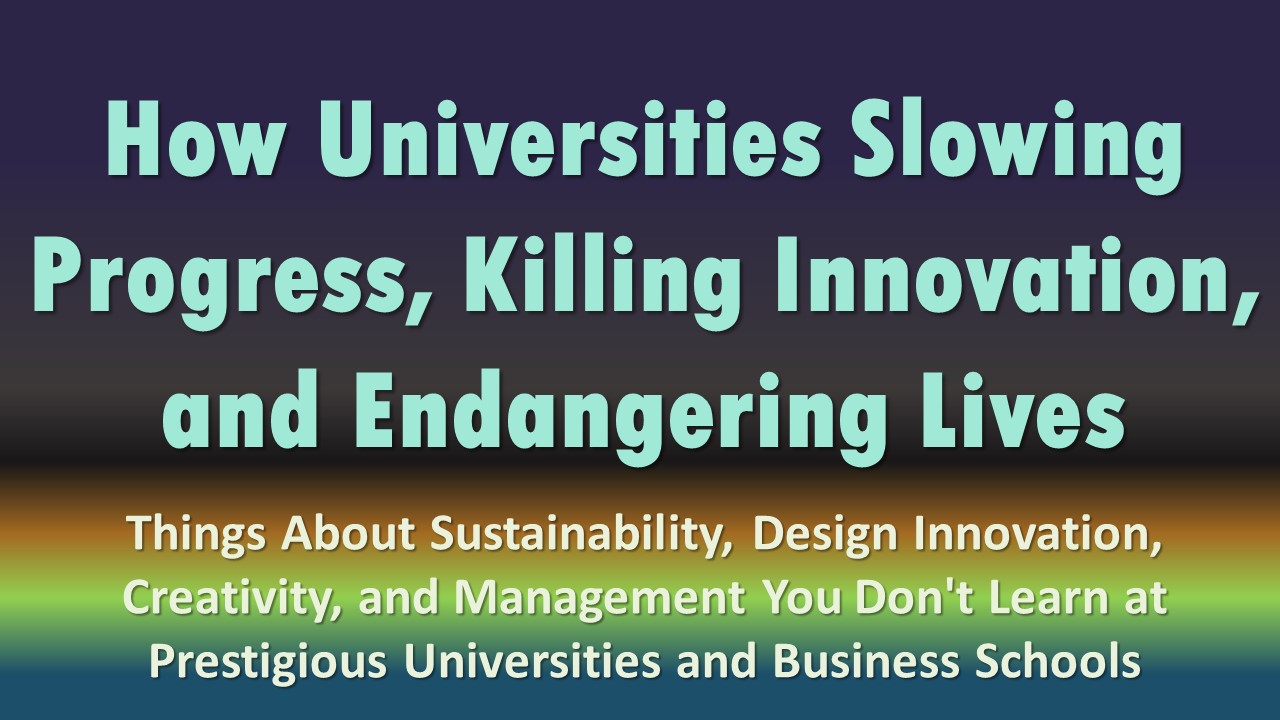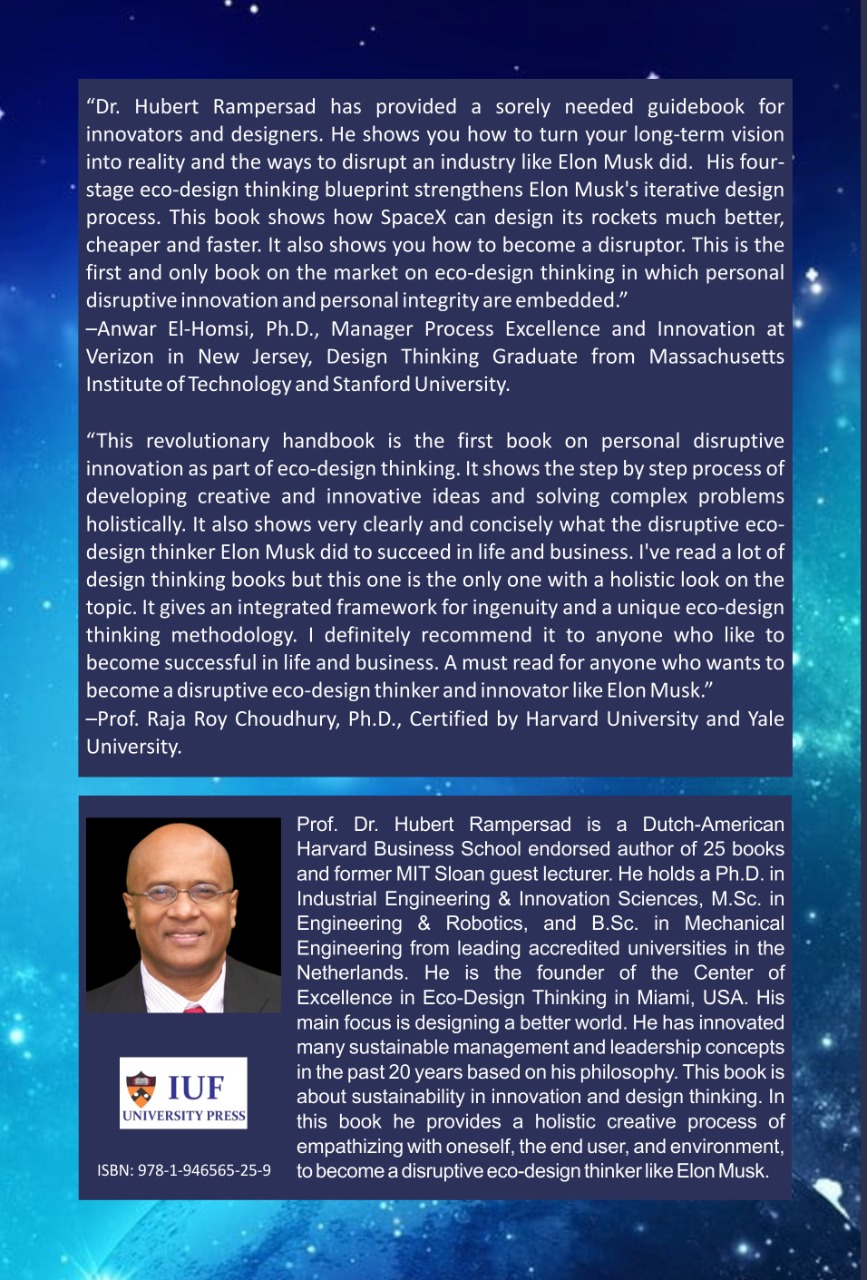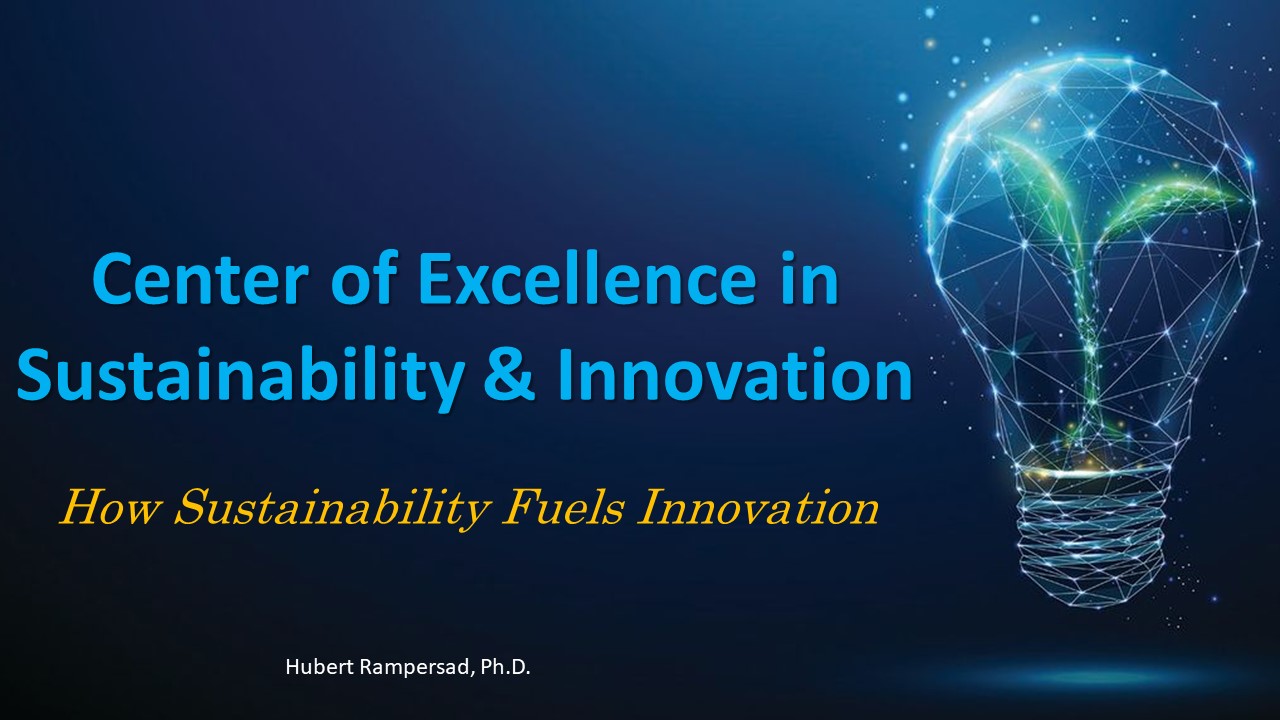Live webinar “Sustainability in the Oil & Gas Industry” by renowned Dr. Hubert Rampersad.
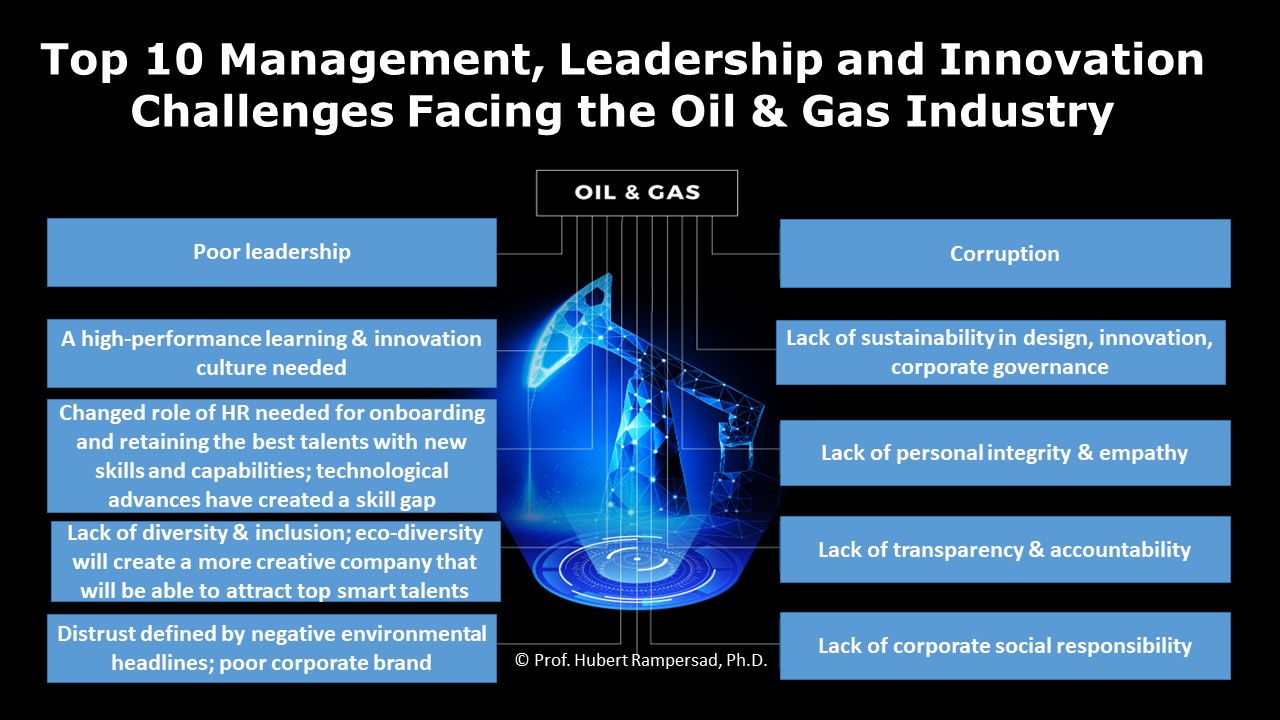
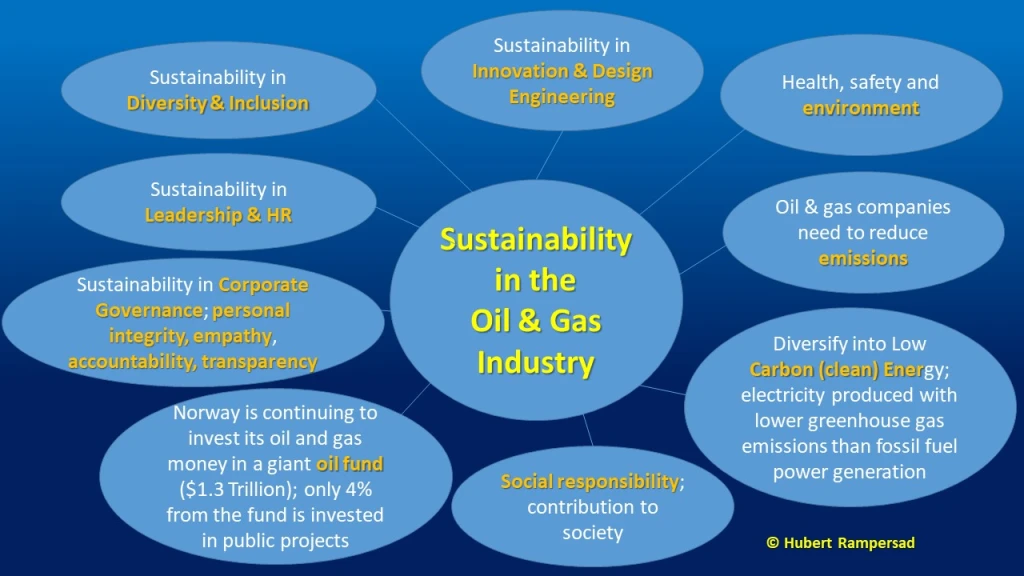
Read further:
How Generative AI Helps Design a Better World
“AI is the future of innovation that helps us generate more creative and imaginative ideas. However, it cannot replace human intelligence and empathy. Therefore, focusing on Personal Disruptive Innovation is imperative to develop critical thinking skills. This will enable us to keep up with AI, future-proof our careers, and adapt to unpredictable circumstances”.– Hubert Rampersad
Innovation is constantly evolving, and with generative AI being the latest wave, humans must focus on personal disruptive innovation to keep up and support AI. It’s important to note that while generative AI is a valuable tool, it cannot replace human intelligence, empathy, integrity, and critical thinking. Combining personal disruptive innovation with generative AI can help us generate more imaginative, innovative, empathetic, and disruptive ideas.
The pandemic has taught us valuable lessons, including the need for a better world characterized by empathy, personal integrity, non-racialism, environmental responsibility, efficiency, circularity, a revised role for human resources, good governance, and ethical leadership. This better world should prioritize sustainability in design innovation, HR, leadership, diversity & inclusion, corporate governance, and higher education. This is illustrated in the accompanying Figure.

“Sustainability involves a holistic and ethical approach that aims to establish a harmonious coexistence between humans and nature for an extended period.”-– Hubert Rampersad. Sustainability begins with the individual.
ESG and SDGs initiatives not sustainable due to short-sightedness
Within organizations, the narrow-mindedness of leaders, project managers, and designers often leads to a lack of creativity, sustainability, and innovation. Unfortunately, many companies’ board of directors may not truly understand the importance of genuine sustainability and sustainable innovation, resulting in missed opportunities to create a better world. While the Environmental, Social, and Governance (ESG) framework has been in place since the 1970s and the Sustainable Development Goals (SDGs) were established by the United Nations General Assembly in 2015, neither framework is comprehensive enough. The SDGs focus on 17 critical areas to address economic, social, and environmental challenges by 2030, while the ESG framework emphasizes environmental, social, and governance factors. However, the SDG framework isn’t sustainable because true sustainability begins with good people, and unfortunately, the world is full of bad people. All 17 SDGs cannot be achieved sustainably without creating good people first, and it’s shortsighted of the UN to overlook this crucial aspect.
“It is important to acknowledge that the Sustainable Development Goals (SDGs) do not include the essential SDG #18: GOOD PEOPLE. To truly address the root causes of climate change, we must move beyond simply treating its symptoms. We must focus on nurturing personal integrity, including being mindful of how our actions and behaviors impact all living beings – humans, animals, and plants. This is the foundation of empathy, crucial for effective action against climate change. Regrettably, the world is full of bad people who don’t prioritize these values, which is why so few are engaged in efforts to combat climate change”. – Hubert Rampersad. Why is this significant shortcoming not addressed by the bureaucratic United Nations?
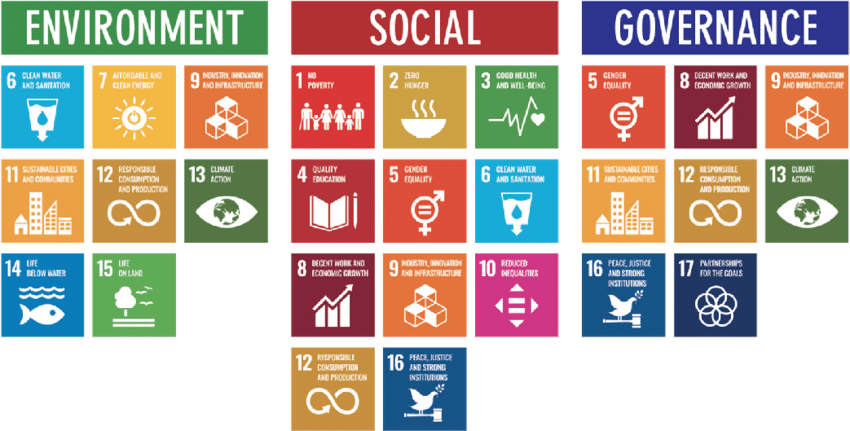
SDG and ESG frameworks operate with the same principle: pursuing sustainability. Their ultimate goal is to achieve Purpose by positively impacting the world. However, it’s important to note that Purpose should not just be a trendy buzzword but a sustainable approach. To learn more about this, please refer to my article: “How SDGs, ESG, and Purpose Fuel Circular & Value-based Design For Sustainability.”

“The approach to addressing climate change is wrong as it only focuses on the symptoms rather than the root causes. It is vital to educate individuals on the significance of personal integrity and how our actions impact the environment, including all living beings. Empathy plays a crucial role in establishing a strong foundation for environmental consciousness, which starts with personal integrity. To combat climate change effectively, we need good people, but unfortunately, the world is full of bad people, which may explain why only a few individuals are actively involved in the fight against climate change”.—Hubert Rampersad
This article will explore the relationship between sustainability, generative AI, and design innovation to design a better world. The content is derived from my latest book, “Eco-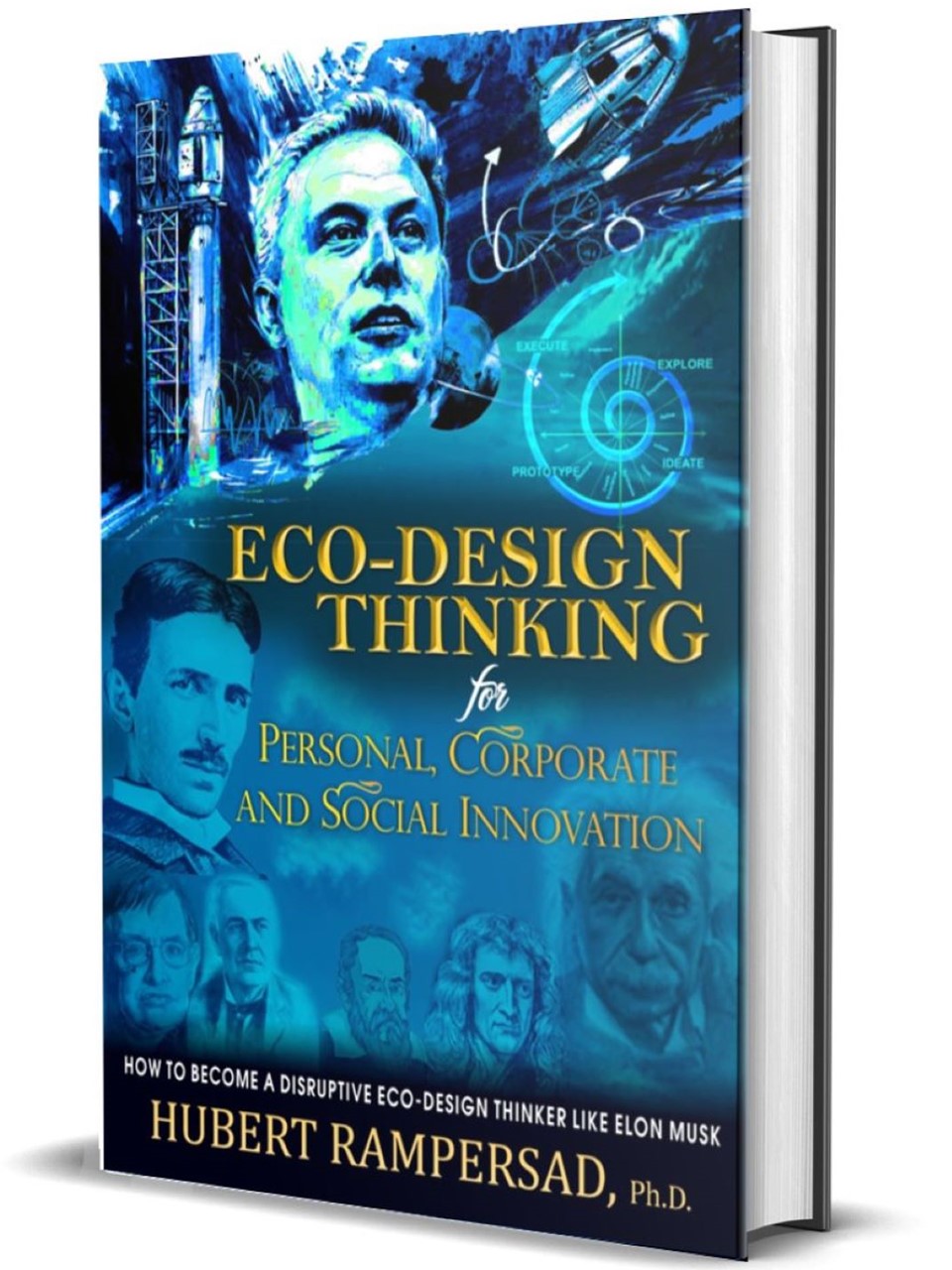 Design Thinking for Personal, Corporate, and Social Innovation: How to Become a Disruptive Eco-Design Thinker Like Elon Musk.” In this excerpt, I discussed the concept of reimagining design innovation. Additionally, I suggest checking out my article “10 Ways to Kill Creativity, Sustainability, and Innovation” for further insights.
Design Thinking for Personal, Corporate, and Social Innovation: How to Become a Disruptive Eco-Design Thinker Like Elon Musk.” In this excerpt, I discussed the concept of reimagining design innovation. Additionally, I suggest checking out my article “10 Ways to Kill Creativity, Sustainability, and Innovation” for further insights.
Read also “How to Fix Stupidity“.
A novel approach to Thinking
To design a better world, we must adopt new design methods and ways of thinking. As Einstein famously stated, “We cannot solve our problems with the same thinking we used when we created them.” That’s where eco-design thinking emerges, shifting from the traditional fixed mindset to a more dynamic growth mindset. The difference between these two approaches is illustrated in the figure below.

Many individuals favor their brain’s left side and ignore the right, resulting in a lack of balance. This limits their ability to approach complex design issues creatively and with authenticity. To help with this, this article presents a comprehensive framework and tools to become an empathetic and innovative eco-design thinker. This aligns with my eco-innovation model, which is explained in detail below.
Sustainable Innovation
In today’s complex world, sustainable innovation is crucial. Traditional innovation approaches are inadequate because they lack a holistic approach. Instead, they are superficial, theatrical, and cozy. Such policies do not align with my definition of genuine sustainability, which entails a holistic and ethical system that fosters long-term coexistence between humans and nature. This is why I introduced my Eco-Innovation concept. 
Eco-Innovation involves integrating sustainability into the process of innovation. I identify three types of innovation that fall under this category:
- Personal innovation is unlocking your creative potential and creating new opportunities for yourself. By disrupting your current market, you can make a significant social impact. Personal Disruptive Innovation by Hubert Rampersad also helps find your purpose in life and improve your business and personal life for greater happiness and health.
- Corporate innovation involves applying new ideas to create new products, processes, or services that increase the value of a company. Corporate innovation also encompasses Open Innovation by Chesbrough, Disruptive Innovation by Clayton Christensen, and BlockChain Innovation.
- Social innovation is developing and implementing new ideas and solutions that meet social needs and strengthen civil society. There is some overlap between social innovation and social entrepreneurship. Social innovation aims to make the world a better place by implementing innovative ideas that create social and environmental change, benefiting many people. Social entrepreneurs seek the most effective ways to achieve their social mission and provide social benefits.
The diagram below shows how personal innovation, corporate innovation, and social innovation are interconnected. Personal innovation is linked to self-learning, corporate innovation is linked to organizational learning, and social innovation is linked to community learning.
Sustainability Starts With Personal Integrity and Empathy
“Empathy is the key to improving the world for animals and humans. Personal integrity is the foundation of empathy, which requires putting aside one’s ego. The higher one’s personal integrity, the more attentive and empathetic they become. This leads to a better design and ultimately happier customers”– Hubert Rampersad.

In this new normal, it is essential to have empathy for humans, animals, and nature. An article by Jane Goodall highlights how disrespect for animals has caused the pandemic. Similarly, Sir David Attenborough has expressed concern about the catastrophic impact that human activity is having on our planet and climate change. In his opinion, humans are a plague on Earth. Genuine empathy requires personal integrity, which I have extensively explained in my article “Reimagining Leadership.” This personal integrity methodology emphasizes the importance of being in harmony with oneself. Remember what Albert Einstein said: “When you examine the lives of the most influential people who have ever walked among us, you discover one thread that winds through them all. They have been aligned first with their spiritual nature and only then with their physical selves.”
Innovative Ideas
Traditional design thinking approaches are unsuitable for a sustainable circular economy as they focus on process-driven, analytical thinking; cozy, theatrical meetings; and completing related tasks in a particular order using design tools. These approaches lack imagination and fail to address the larger picture. Remember what Albert Einstein said: “The true sign of intelligence is not knowledge but imagination. Logic will get you from A to B. But imagination will take you everywhere… When I examine myself and my methods of thought, I conclude that the gift of fantasy has meant more to me than any talent for abstract, positive thinking… The intuitive mind is a sacred gift, and the rational mind is a faithful servant. We have created a society that honors the servant and has forgotten the gift.”
Traditional design thinking methods taught at prestigious institutions like Stanford, MIT, and Harvard heavily rely on group meetings. However, having these cozy meetings is unnecessary for developing innovative ideas. In fact, research suggests that p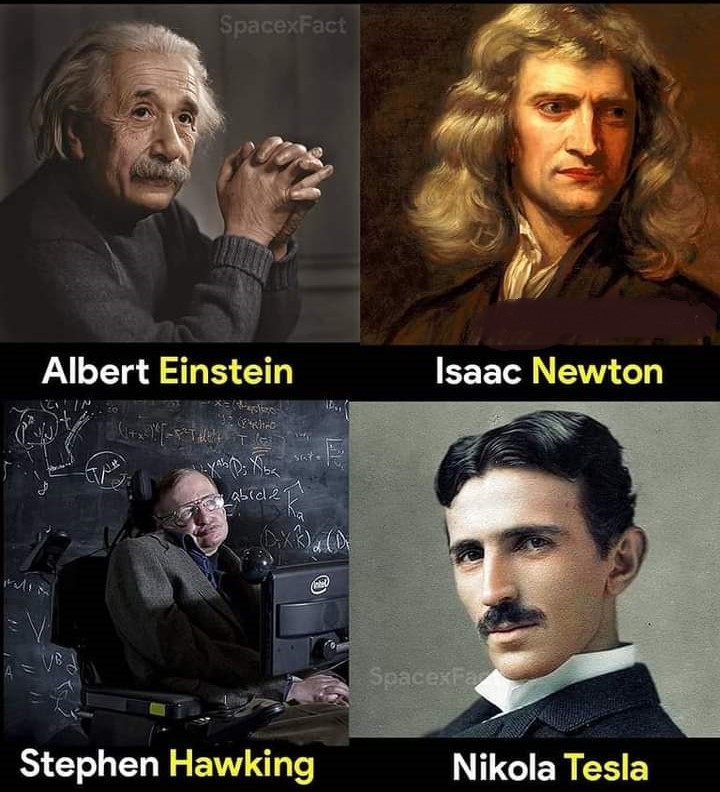 People tend to be more creative when working alone than in groups. Some of the best ideas have been generated by individuals working independently. For instance, Nikola Tesla developed many innovative ideas while working alone for over thirty years. Similarly, Stephen Hawking made significant discoveries while confined to his wheelchair, and Sir Isaac Newton famously discovered gravity while in social isolation.
People tend to be more creative when working alone than in groups. Some of the best ideas have been generated by individuals working independently. For instance, Nikola Tesla developed many innovative ideas while working alone for over thirty years. Similarly, Stephen Hawking made significant discoveries while confined to his wheelchair, and Sir Isaac Newton famously discovered gravity while in social isolation.
 Remember what Nikola Tesla said: “Being alone is when ideas are born. This is the secret of innovation”. Albert Einstein said almost the same: “Be a loner. That gives you time to wonder, to
Remember what Nikola Tesla said: “Being alone is when ideas are born. This is the secret of innovation”. Albert Einstein said almost the same: “Be a loner. That gives you time to wonder, to Search for the truth. Have holy curiosity. Make your life worth living”.
Search for the truth. Have holy curiosity. Make your life worth living”.
In the following section, I will discuss the concept of personal disruptive innovation, which offers a way to cultivate creativity while working alone, without the need for in-person brainstorming sessions. By utilizing eco-design thinking, you can generate great ideas using only yourself.
Personal Disruptive Innovation
To be discussed in the next section, the eco-design thinking model starts with personal disruptive innovation to understand, explore, redefine, and redesign yourself before solving the design problem. You need to become innovative and empathic first to develop innovative designs for the end users. You need to develop disruptive skills first. You need to reinvent and redesign yourself first to become a disruptor. In the upcoming section, I will discuss the eco-design thinking model, which emphasizes personal disruptive innovation as the first step towards understanding, exploring, redefining, and redesigning oneself before solving any design problems. Being innovative and empathic is essential to develop innovative designs that cater to the end users’ needs. Therefore, developing disruptive skills and reinventing oneself to become a disruptor is necessary.
become innovative and empathic first to develop innovative designs for the end users. You need to develop disruptive skills first. You need to reinvent and redesign yourself first to become a disruptor. In the upcoming section, I will discuss the eco-design thinking model, which emphasizes personal disruptive innovation as the first step towards understanding, exploring, redefining, and redesigning oneself before solving any design problems. Being innovative and empathic is essential to develop innovative designs that cater to the end users’ needs. Therefore, developing disruptive skills and reinventing oneself to become a disruptor is necessary.
Personal disruptive innovation is an innovation that can unlock your creative potential, open up new unique opportunities, challenge traditional markets, and allow you to make a meaningful impact on society. You can break free from conventional thinking and expand your horizons by embracing innovation. In this way, you will not think outside the box; you will think like there is no box. To become more resilient and develop your authenticity and strategic thinking skills, follow the four steps below. Read my article for more information: “4 Steps to Cultivate Authenticity, Integrity, Empathy, and Sustainability”.

 The roadmap for personal innovation begins with personal ambition, founded on self-knowledge. It’s important to remember that: All knowledge begins with self-knowledge, all learning begins with self-learning, all innovation starts with self-innovation (personal innovation), and authentic empathy begins with personal integrity. Self-knowledge involves knowing oneself. Remember what Aristotle said: “Knowing yourself is the beginning of all wisdom.” Elon Musk learned a lot from Aristotle. Remember, “To be more innovative and creative, individuals should focus more on cultivating self-knowledge.”. –– Hubert Rampersad.
The roadmap for personal innovation begins with personal ambition, founded on self-knowledge. It’s important to remember that: All knowledge begins with self-knowledge, all learning begins with self-learning, all innovation starts with self-innovation (personal innovation), and authentic empathy begins with personal integrity. Self-knowledge involves knowing oneself. Remember what Aristotle said: “Knowing yourself is the beginning of all wisdom.” Elon Musk learned a lot from Aristotle. Remember, “To be more innovative and creative, individuals should focus more on cultivating self-knowledge.”. –– Hubert Rampersad.
By defining your personal mission, vision, and critical roles, you can uncover your true purpose and understand the meaning of your life. Remember what Elon Musk, the disruptor said: “Don’t even attach yourself to a person, a place, a company, an organization, or a project. Attach yourself to a mission, a calling, a purpose only. That’s how you keep power and your peace. It worked pretty well for me this far”. Further reading: “4 Steps to Become Resilient and Cultivate a Growth Mindset”.
Personal Disruptive Innovation and Generative AI
Generative artificial intelligence or generative AI is an artificial intelligence (AI) system that can learn the patterns and structure of the input training data. Afterward, it can generate new data with similar characteristics. This system can create new audio, text, images, and video content based on user prompts. These tools can replace humans in many jobs. Generative AI tools such as ChatGPT, Stable Diffusion, and Midjourney (just to name a few)
that can learn the patterns and structure of the input training data. Afterward, it can generate new data with similar characteristics. This system can create new audio, text, images, and video content based on user prompts. These tools can replace humans in many jobs. Generative AI tools such as ChatGPT, Stable Diffusion, and Midjourney (just to name a few)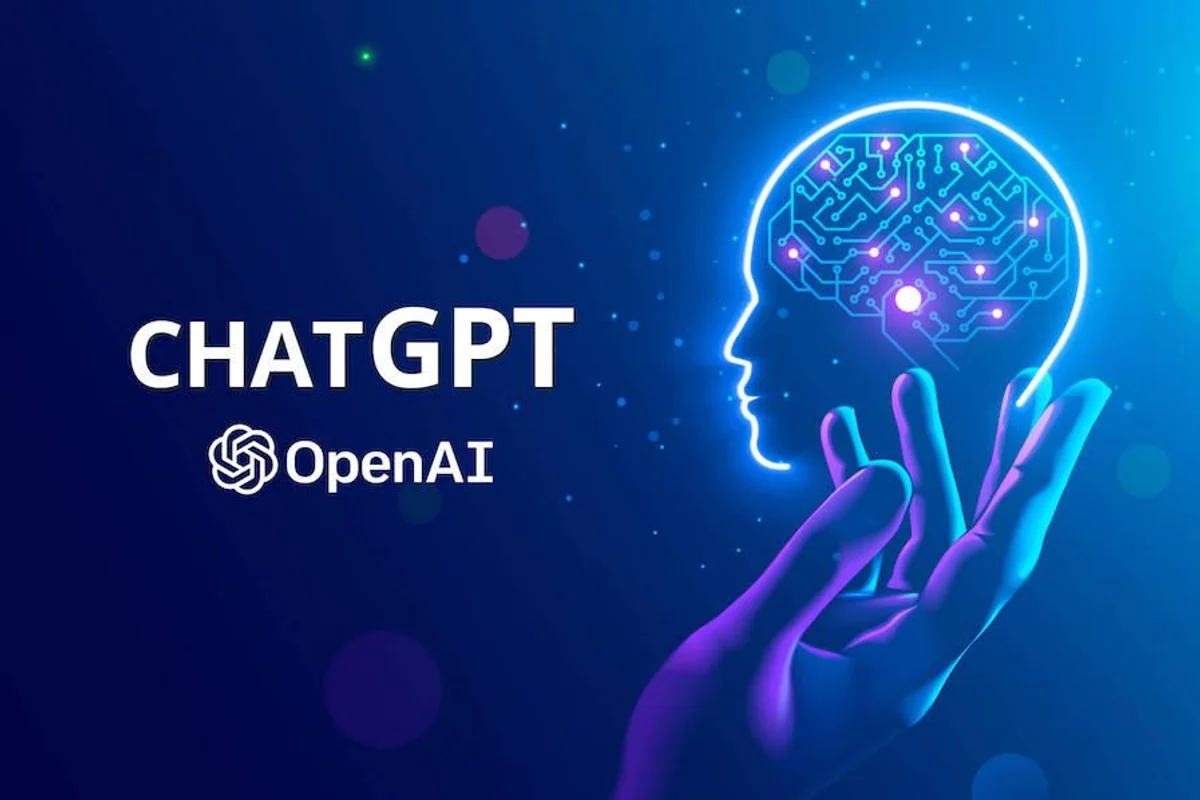 are trained with massive amounts of online data to generate engaging text and images in response to user prompts. The popular ChatGPT is an artificial intelligence chatbot (a large language model) developed by OpenAI. Please take a look at this “Top 35 Generative AI Tools by Category”.
are trained with massive amounts of online data to generate engaging text and images in response to user prompts. The popular ChatGPT is an artificial intelligence chatbot (a large language model) developed by OpenAI. Please take a look at this “Top 35 Generative AI Tools by Category”.
With generative AI being the newest innovation, it is essential to concentrate on personal disruptive innovation to keep up with and aid generative AI. It’s important to note that generative AI cannot replace human intelligence, thinking, integrity, and empathy. Combining personal disruptive innovation and generative AI tools like ChatGTP and Stable Diffusion can help humans generate more innovative, imaginative, disruptive, empathetic, and creative ideas.
Read the recent Harvard Business Review Article “How Generative AI Can Augment Human Creativity” (July-August 2023), authored by Tojin T. Eapen, Daniel J. Finkenstadt, Josh Folk, Lokesh Venkataswamy. They explored the potential of different generative AI tools to stimulate creative thinking by merging numerous ideas to generate even stronger ones. These AI tools can help overcome biases like design fixation, encourage exploring new problem-solving methods, create innovative solutions, and assist in evaluating ideas using ChatGPT. Additionally, they can support the refinement of ideas and facilitate collaboration among end-users. However, their article omitted the crucial aspect of holistically integrating these AI tools into a new holistic design process to use them effectively. This gap was also noted at academic institutions like MIT, Stanford, and Harvard.
Although their HBR article highlights the connection between creative idea generation, problem-solving, and generative AI tools, it fails to address the effective use of such devices in sustainable innovation efforts across various sectors, including businesses, academic institutions, governments, and militaries. It is widely understood that generative AI will not replace humans entirely. Therefore, it is essential to ensure that humans can work alongside these innovative tools in harmony and efficiently use them. Launching a new comprehensive and holistic design model that integrates generative AI and genuine sustainability would be worthwhile.
Is it not better to begin the new design process by first developing innovative, intelligent, truthful, and empathic designers who can use generative AI optimally in the later stages? It seems odd that traditional design models neglect this crucial initial step and instead prioritize empathizing with end users. Shouldn’t we revise the design process to create a more sustainable world in the age of generative AI? In the following section, I will introduce a new design model to help companies, academic institutions, governments, and militaries make better use of generative AI in their design process. This will lead to more innovative, imaginative, disruptive, empathetic, and creative ideas.
Eco-Design Thinking Model; A Generative AI-Friendly Design Process
My article “Top-10 Causes of Bad Designs” highlights the negative impact of bad designs due to a lack of consideration for sustainability and generative AI.  Some well-known examples of such designs include the botched vaccine rollout in America, Citibank’s loss of $500 million due to an unfriendly loan management tool, the $2 trillion F-35 project, Boeing 737 Max airplane, the T-14 Armata Russian Tank, and the Samsung Galaxy Note 7. Please take the time to read my article “Why OceanGate’s Design Approach Sucks; How the Doomed Titan Sub Tragedy Could Have Been Avoided”. CEOs who prioritize their personal design choices over critical safety regulations, endangering human lives, can learn a valuable lesson from the tragedy of the Titan. This also applies to individuals like Elon Musk and companies like Boeing. Please look at my article “How could Elon Musk’s $3 billion Mars rocket failure have been avoided”. The following figure displays the top 10 reasons for bad designs.
Some well-known examples of such designs include the botched vaccine rollout in America, Citibank’s loss of $500 million due to an unfriendly loan management tool, the $2 trillion F-35 project, Boeing 737 Max airplane, the T-14 Armata Russian Tank, and the Samsung Galaxy Note 7. Please take the time to read my article “Why OceanGate’s Design Approach Sucks; How the Doomed Titan Sub Tragedy Could Have Been Avoided”. CEOs who prioritize their personal design choices over critical safety regulations, endangering human lives, can learn a valuable lesson from the tragedy of the Titan. This also applies to individuals like Elon Musk and companies like Boeing. Please look at my article “How could Elon Musk’s $3 billion Mars rocket failure have been avoided”. The following figure displays the top 10 reasons for bad designs.
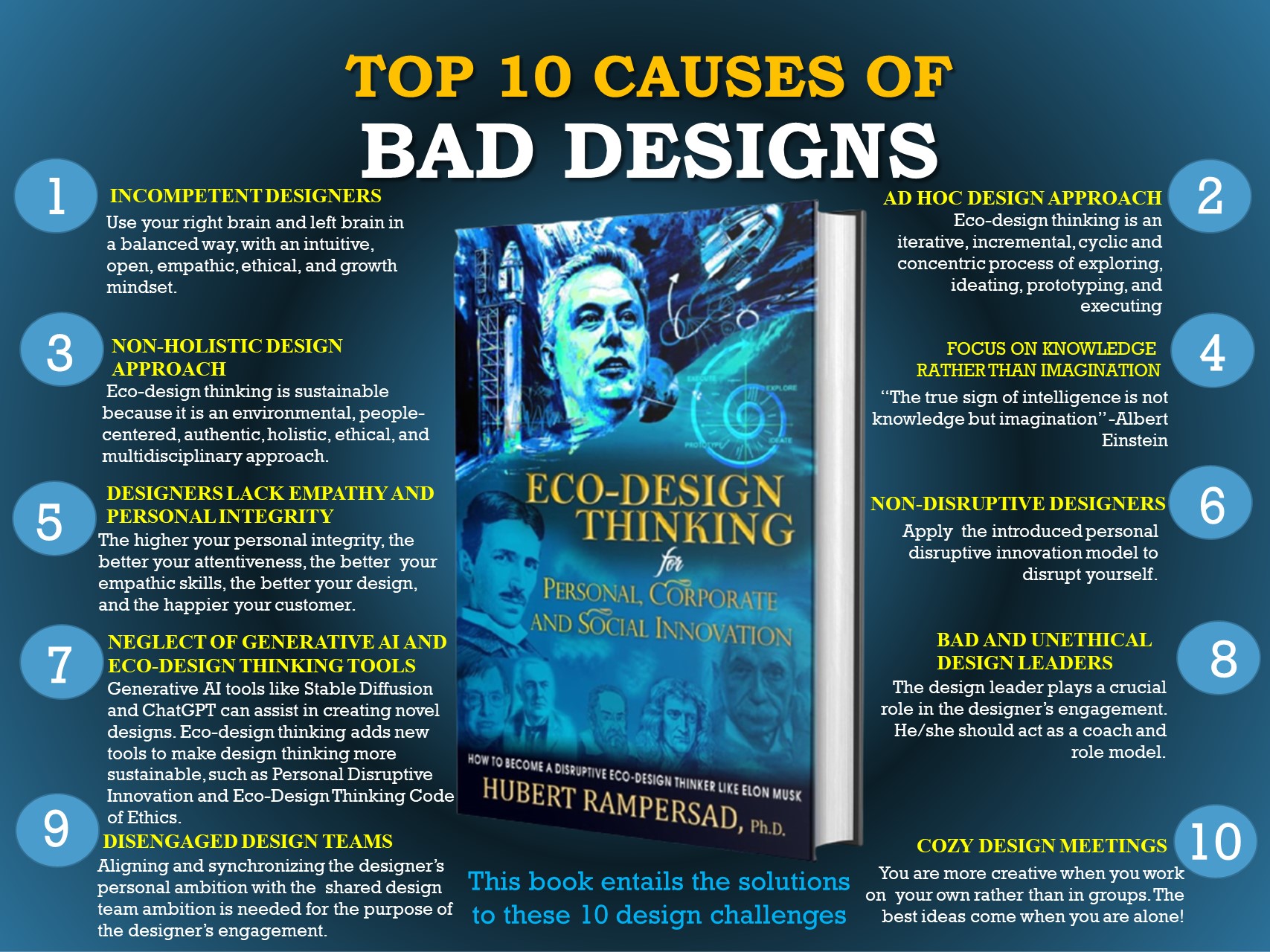
We must adopt a new design method better suited for generative AI to design a more sustainable world. This method should prioritize creating intelligent, resilient, empathetic, and honest designers. To achieve this goal, I have introduced eco-design thinking. This creative process involves empathizing with yourself, the end user, and the environment to generate innovative, imaginative, empathetic, and disruptive design ideas. The new model is depicted in the figure below and consists of four stages: Explore, Ideate, Prototype, and Execute. It is an iterative, incremental, cyclic, and concentric process of exploring, ideating, prototyping, and executing (Rampersad, 2022). AI-powered tools that generate content can be helpful in every stage of the design process.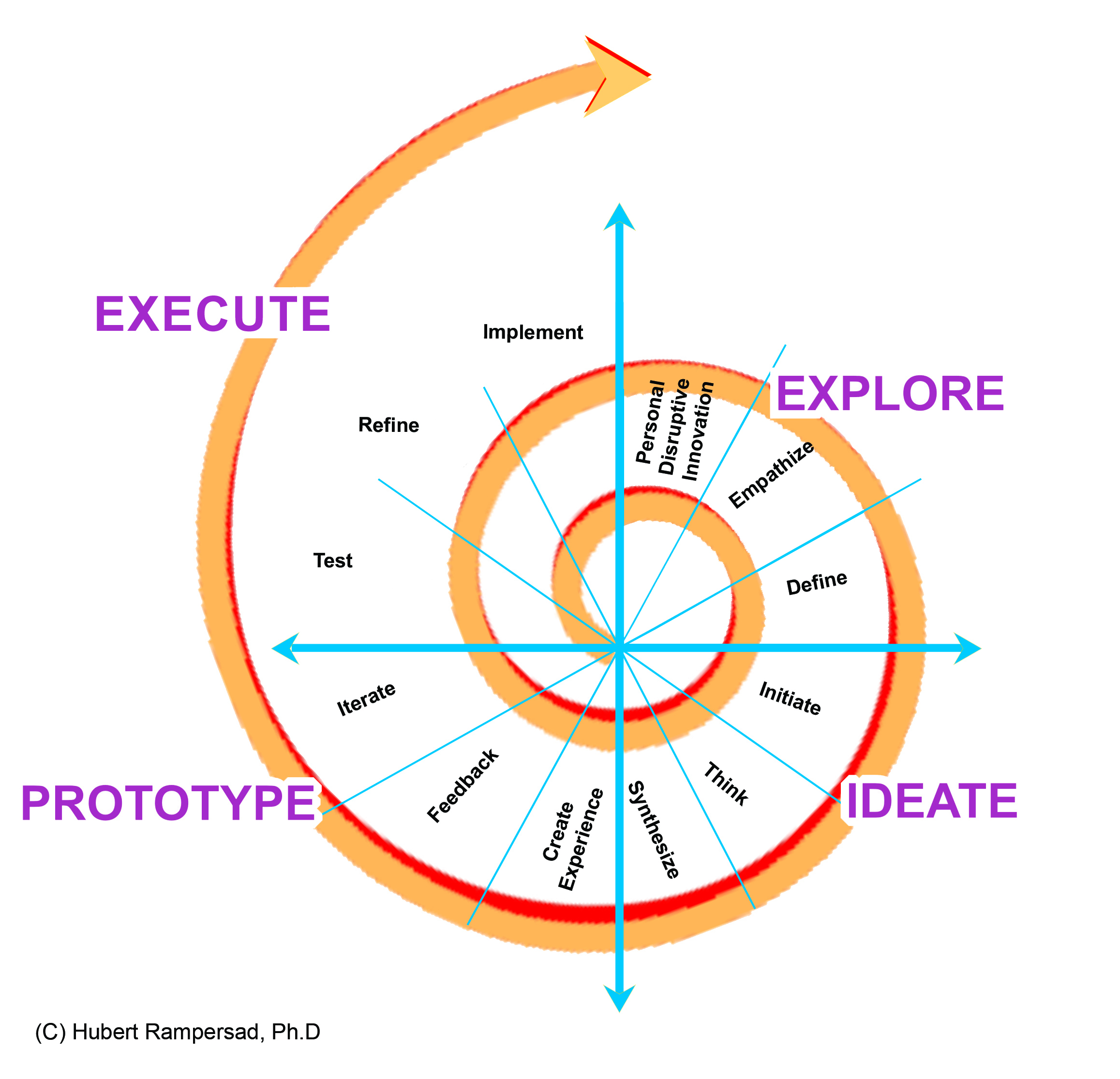 Eco-design thinking is a circular and iterative process that has no endpoint. The model consists of various stages that may form iterative loops and do not need to follow a specific sequence. Every iteration brings forth fresh insights. It is recommended that this process be repeated until the issues of the designer and end-user reach an acceptable level. Eco-design thinking is a continuous and circular process that requires testing and refining your design while empathizing with yourself, the users, and the environment. At any design stage, generative AI tools can aid in producing the best empathic design that is customized to the needs of the end user and the environment.
Eco-design thinking is a circular and iterative process that has no endpoint. The model consists of various stages that may form iterative loops and do not need to follow a specific sequence. Every iteration brings forth fresh insights. It is recommended that this process be repeated until the issues of the designer and end-user reach an acceptable level. Eco-design thinking is a continuous and circular process that requires testing and refining your design while empathizing with yourself, the users, and the environment. At any design stage, generative AI tools can aid in producing the best empathic design that is customized to the needs of the end user and the environment.
Deficiencies in Elon Musk’s design methodology
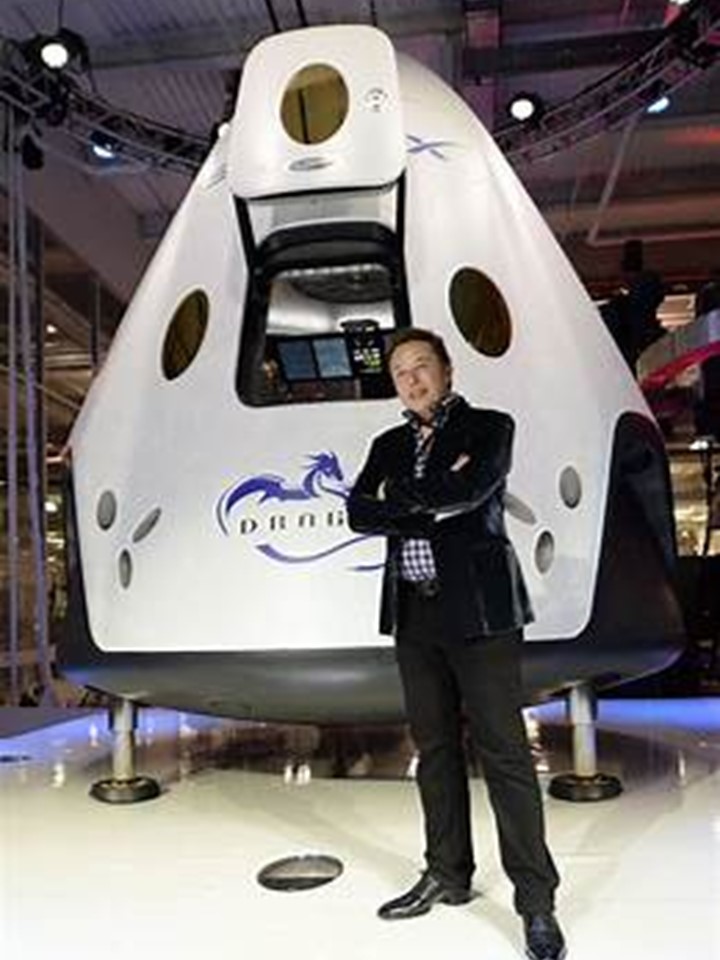 The eco-design thinking model is partly similar to Elon Musk’s iterative design process. This technique involves creating a product or process through a cyclic process of prototyping, evaluating, analyzing, and refining. Rather than investing in a large, costly spaceship to transport humans to Mars, Musk created smaller rockets and continually improved his design. Iterative design, in the case of SpaceX, includes checking the spacecraft, finding potential defects, repairing them, and developing the project.
The eco-design thinking model is partly similar to Elon Musk’s iterative design process. This technique involves creating a product or process through a cyclic process of prototyping, evaluating, analyzing, and refining. Rather than investing in a large, costly spaceship to transport humans to Mars, Musk created smaller rockets and continually improved his design. Iterative design, in the case of SpaceX, includes checking the spacecraft, finding potential defects, repairing them, and developing the project.
Incorporating personal disruptive innovation and eco-design thinking into Elon Musk’s iterative design process could lead to more innovative, better, cheaper, and faster rocket designs. All designers at SpaceX must adopt the mindset of disrupting themselves, just like Musk. Personal disruptive innovation is the crucial missing component in his design process. Without this innovative start to the design process, designers may struggle to keep up with generative AI and miss out on opportunities to develop more imaginative, empathic, and creative design ideas. It’s not surprising that his Mars rocket failed.
The process of eco-design thinking involves exploring, ideating, prototyping, and executing different aspects of a design. Each iteration is then reviewed to identify additional requirements, and the process is repeated to produce a new and improved version of the product or service. The model involves creating a rough product or process in one iteration, reviewing it, and then improving it in the next iteration until it is complete. Based on the results of incremental prototyping and execution, changes and refinements are made to the most recent iteration of the design.
To create a good design, it’s essential to first explore your life, empathize with the end user, and research the environment. Once you’ve identified the design problem and user needs, you can generate ideas to meet those needs. From there, you’ll develop a prototype of the finished product or service and test it to ensure it’s meeting the requirements in the best possible way. If adjustments need to be made based on the test results, you’ll adjust the design accordingly and execute the solution. If the prototype doesn’t meet the need, you’ll create a new one and start the process again until the end user is satisfied.
The 4 Stages in the Eco-Design Thinking Model
Let’s examine the four stages of the eco-design thinking model more closely, as outlined in my new book (Rampersad, 2022):
EXPLORE
The first step in this design process is to empathize with yourself, examine and redesign your own life and reinvent yourself before tackling the design problem. This will give you a better understanding of yourself and the design challenge. The goal is to transform yourself into an innovative, empathetic disruptor who can keep up with generative AI and use generative AI tools effectively to generate more inventive, imaginative, disruptive, empathetic, and creative ideas. The exploration phase includes three sub-phases:
- Personal disruptive innovation: Personal disruptive innovation refers to a groundbreaking innovation that unleashes your creative potential, creates innovative personal opportunities, disrupts your current target market, and enables you to make a notable social impact. This type of innovation is based on a framework and
 roadmap that helps you explore your life, develop resilience, reinvent and redesign your life, cultivate your personal eco-design thinking brand, and uphold personal integrity. By unlocking your creative potential, personal disruptive innovation allows you to disrupt the usual course of your life. Before exploring the design problem, it’s essential to understand yourself and your environment empathetically. This initial stage focuses on exploring your life. Personal disruptive innovation also involves creating a powerful personal brand for compelling storytelling
roadmap that helps you explore your life, develop resilience, reinvent and redesign your life, cultivate your personal eco-design thinking brand, and uphold personal integrity. By unlocking your creative potential, personal disruptive innovation allows you to disrupt the usual course of your life. Before exploring the design problem, it’s essential to understand yourself and your environment empathetically. This initial stage focuses on exploring your life. Personal disruptive innovation also involves creating a powerful personal brand for compelling storytelling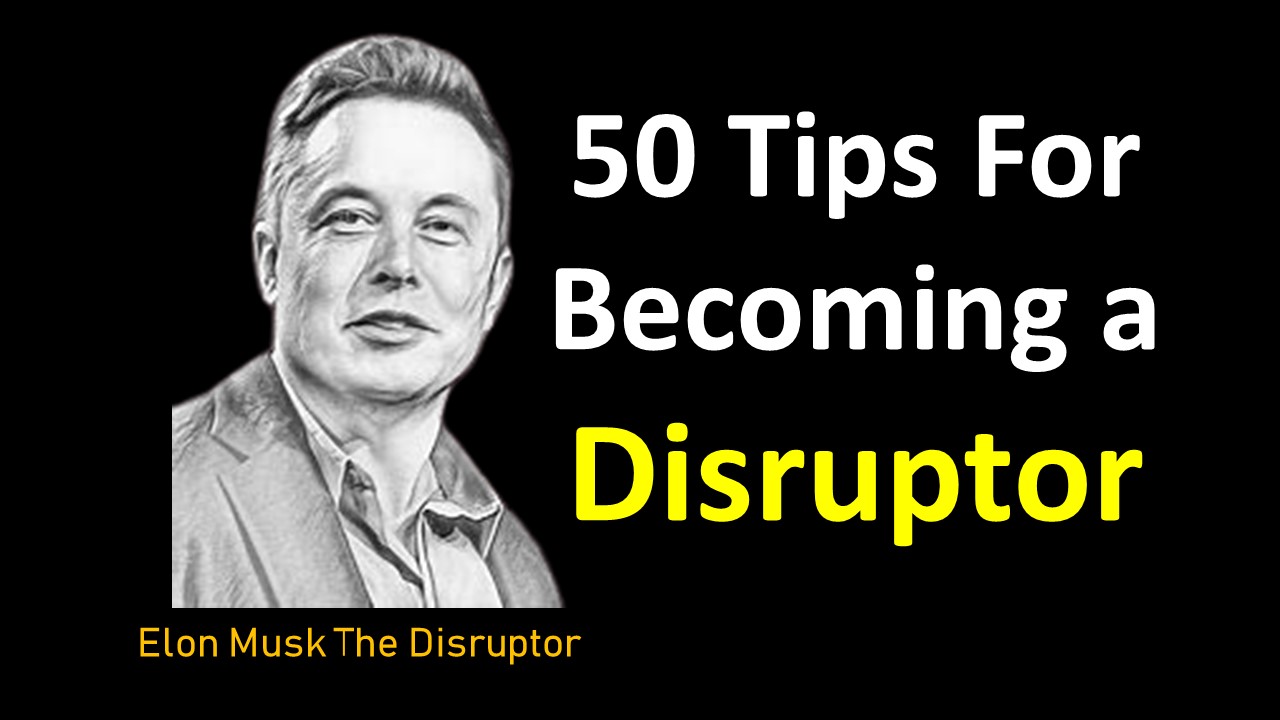 during every step of the design process, using eco-design thinking. Elon Musk, the disruptor, is currently the world’s most powerful personal brand and a brilliant storyteller. He connects emotionally with his audience, creating a solid bond. ChatGTP is a helpful tool for improving storytelling. I recommend reading my article “50 Tips For Becoming a Disruptor“. Additionally, my article “Personal Disruptive Innovation” provides further insights.
during every step of the design process, using eco-design thinking. Elon Musk, the disruptor, is currently the world’s most powerful personal brand and a brilliant storyteller. He connects emotionally with his audience, creating a solid bond. ChatGTP is a helpful tool for improving storytelling. I recommend reading my article “50 Tips For Becoming a Disruptor“. Additionally, my article “Personal Disruptive Innovation” provides further insights. - Empathize: Before moving forward, gaining a compassionate understanding of the end user and the issue that needs to be resolved is essential. This can be achieved by listening to their stories, observing their behavior, and engaging with them. By empathizing with the end user, we can better understand their experiences and develop a personal connection with the problem. It’s equally essential to empathize with ourselves and the surrounding environment.
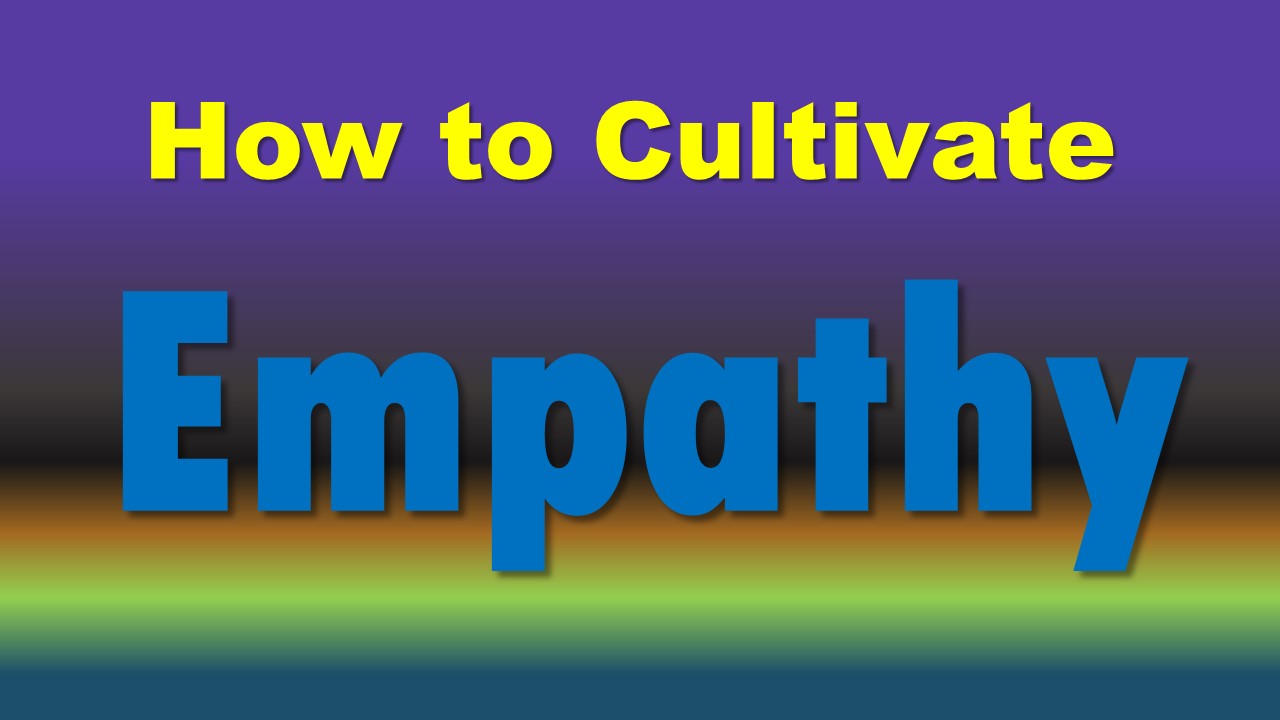 To design effectively, it is necessary to have empathy and understand the needs of yourself, the end user, and the environment. I recommend reading my article on “How to Cultivate Empathy.” During this stage, generative AI can enhance collaborations between designers and end-users of the product. It also enables end-users to empathize with each other more effectively.
To design effectively, it is necessary to have empathy and understand the needs of yourself, the end user, and the environment. I recommend reading my article on “How to Cultivate Empathy.” During this stage, generative AI can enhance collaborations between designers and end-users of the product. It also enables end-users to empathize with each other more effectively. - Define: During this stage, you will compile the information that was collected during your empathetic research, analyze your observations, interpret the empirical findings, and define the problem in a way that is centered around the customer. The end result should be a problem statement that is customer-focused and human-centered. ChatGTP is available to help you formulate a compelling statement.
IDEATE
The ideate phase is composed of three sub-phases, which are:
- Initiate: Choose a facilitator who can effectively initiate and manage discussions, revisit the problem, and establish guidelines for brainstorming and generative AI tools. It is essential that the chosen facilitator has experience with the personal disruptive innovation method and has applied it to himself.
- Think: Engaging in divergent and convergent thinking is essential to develop innovative design ideas. Begin by spending approximately one-third of the allotted time on divergent thinking, which involves generating multiple solutions to a problem without being constrained by traditional approaches. Then, allocate around one-sixth of the time to convergent thinking, which entails refining and strengthening ideas by combining and building upon them. Remember to write down all ideas to keep track of them. Convergent thinking and divergent thinking are two opposite approaches. While convergent thinking focuses on finding the best solution to a problem, the generative AI tool Stable Diffusion can support divergent thinking by connecting product ideas and generating fresh ideas. By encouraging designers to think like there is no box and consider new possibilities for a product’s form and function, Stable Diffusion can help them arrive at innovative solutions they may not have thought otherwise. This is a departure from traditional design methods prioritizing function over form. With Stable Diffusion, designers can use a series of prompts to build upon their ideas and create impactful visual designs, read Eapen et al. (2023). With ChatGPT, you can evaluate the advantages and disadvantages of new concepts and choose the optimal solution.
- Synthesize: To create a coherent whole, it is essential to combine various product ideas. Use one-third of the allocated time to synthesize your ideas. Analyze and connect your thoughts, and choose the strongest to create themes. Cluster similar ideas together and select the best clusters. Assign a group to each set to evaluate the ideas, and hold separate follow-up meetings to eliminate any unusable ideas based on selection criteria. During this synthesis phase, you can use Stable Diffusion to quickly evaluate a wide range of product concepts based on the most important criteria and combine them into a cohesive whole.
PROTOTYPE
The prototype phase is made up of three sub-phases, which are:
- Create an experience: After implementing solutions into the prototypes, they are evaluated based on user experiences. It is essential to guide the end users through the prototype to allow them to experience it firsthand. During this stage, generative AI tools like Stable Diffusion and Midjourney can assist in creating product storyboards. At the same time, ChatGPT can aid in improving the design and helping the end users understand the prototype. Collaborations between designers and end users can be enhanced using generative AI to co-create better strategies. Designers can benefit from the assistance of generative AI in effectively communicating their designs through both written and visual formats, resulting in more creative and intelligent designs. Additionally, generative AI can provide crucial details that make the design more understandable and feasible. Here’s an excellent storyboard example where (Eapen et al., 2023) utilized the Stable Diffusion generative AI tool to create a design for a flying car.
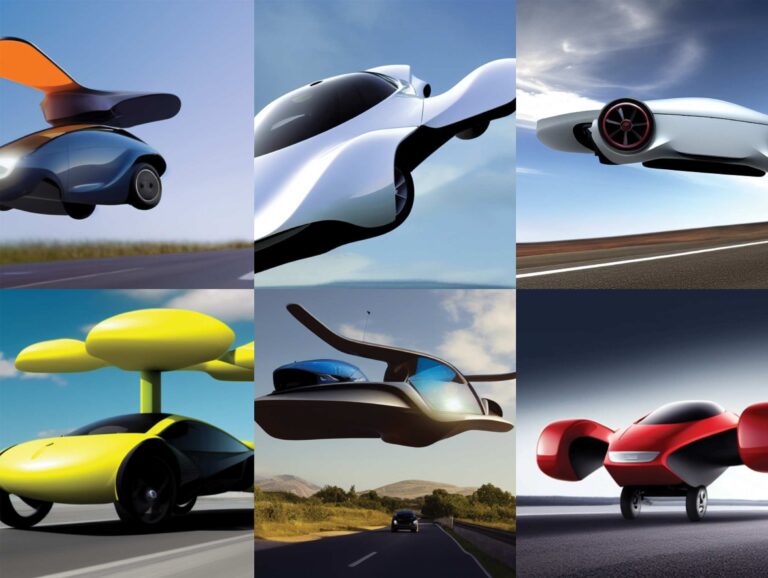 . Feedback: You can develop an improved solution by listening to customer feedback. It may be helpful to utilize storytelling once again to gather feedback. Generative AI can aid in accepting new ideas from the user, while Stable Diffusion can help design a better solution.
. Feedback: You can develop an improved solution by listening to customer feedback. It may be helpful to utilize storytelling once again to gather feedback. Generative AI can aid in accepting new ideas from the user, while Stable Diffusion can help design a better solution. - Iterate: If the end user disapproves of the solution and provides negative feedback, you must make adjustments and repeat the process. This involves modifying the prototype based on the feedback received. If the end user is not content with the results, redefining the issue and empathizing with them more effectively is essential. During this stage, generative AI can help by comprehending the end user better, which can reduce the number of iterations. Consequently, design costs and time will be decreased.
EXECUTE
The execute phase is made up of three sub-phases:
- Test: When presenting the prototype, it is essential to allow the end user to fully experience it. Through testing, you can determine whether the solution is effective or not. The tragedy of the OceanGate Titan submarine could have been avoided if proper testing was performed before its use. Under no circumstances should the sub be used for commercial deep dive missions until it has been thoroughly tested. ChatGTP’s storytelling feature can also gather consumer feedback on how the final product or service is used in real life. This feedback can help designers understand users’ empathic experience when using the product or service. During this stage, generative AI can improve the design by facilitating communication between the designer and the end user, making it more easily understood.
- Refine: If the testing phase doesn’t yield positive results, it will be necessary to go through another round of iteration to refine the design. After testing, the process can be repeated to improve the solution or move on to the implementation stage if the end-user approves. During this stage, generative AI can be utilized again to create a better design.
- Implement: Once the final solution has been approved, it will be implemented, realized, and communicated. Take pleasure in the eco-design thinking experience and note what you have learned and unlearned throughout the design process. Celebrate any accomplishments and move forward to the next project. During this phase, generative AI can once again assist in creating an even better design and documenting the learning process.
Using ChatGTP for storytelling can be incredibly useful in various stages of the design process. It helps to engage customers and create an emotional connection with them. It’s also helpful in defining problems and building empathy and trust with users. Additionally, it can help to determine the most appropriate solution and validate its efficiency. Gathering feedback from user experiences with prototypes can also help improve the final product or service. Lastly, it helps to understand the users’ empathic experience when using the product or service. Generative AI can assist in this storytelling process.
Business Case: AI Designs Unique Walking Robot in Seconds
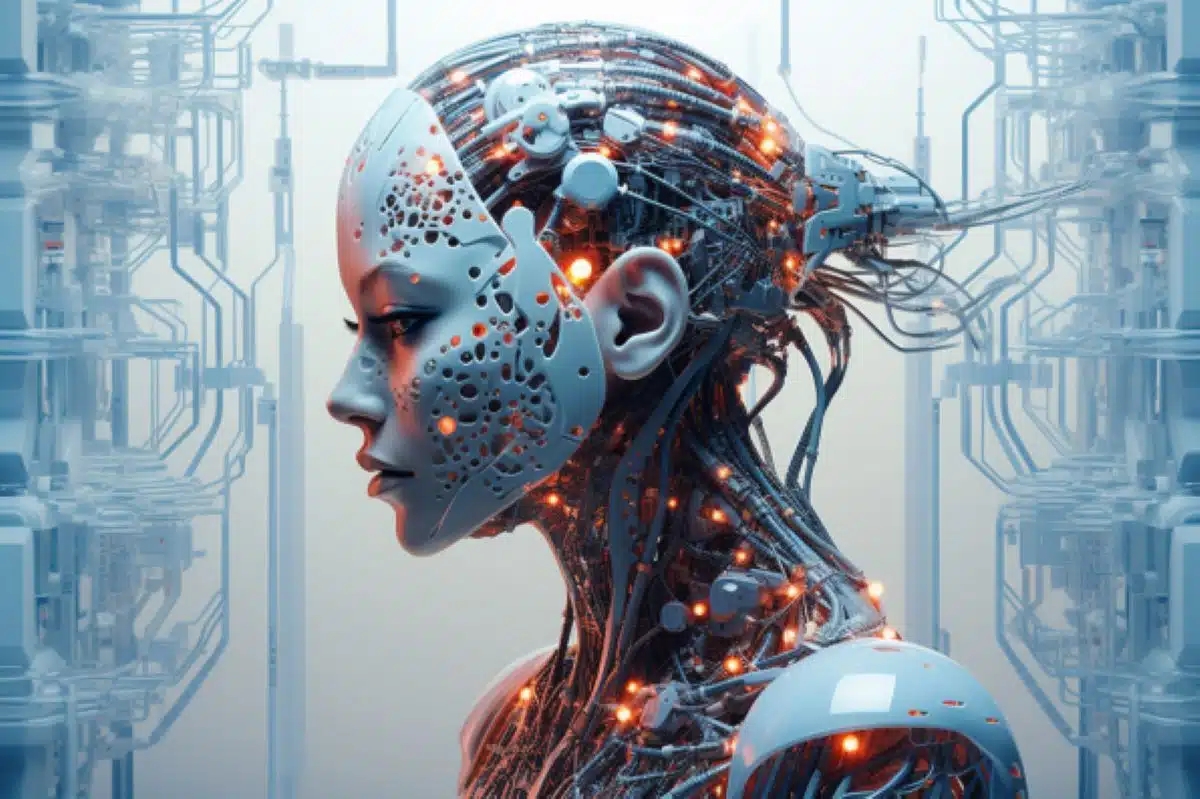
AI appears to design smarter and faster than humans, as this example shows. Researchers at Northwestern University have led a team to create the first-ever artificial intelligence (AI) that can design robots intelligently from scratch. While the AI program can start with any prompt, the researchers began with a simple request to design a physical machine capable of walking on a flat surface, which it did in just 26 seconds on a basic laptop. That’s where the researchers’ input ended and the AI took over. The AI began with a static block the size of a bar of soap that could jiggle but not walk. It then iterated on the design, assessing, and identifying flaws in each iteration to refine the simulated block’s structure until it evolved into a functional walking robot. This breakthrough showcases an unprecedented speed in robotic design and evolution, read “AI Designs Unique Walking Robot in Seconds“.
Bigger Picture
Eco-Design Thinking is a crucial aspect of the broader Eco-Innovation approach. It also involves designer engagement, promoting authentic leadership within design teams, and genuine diversity & inclusion. Additionally, it requires aligning personal innovation with corporate innovation and cultivating a sense of personal integrity and empathy. The figure below illustrates the alignment needed between de designer and his/her design team to enhance employee engagement.
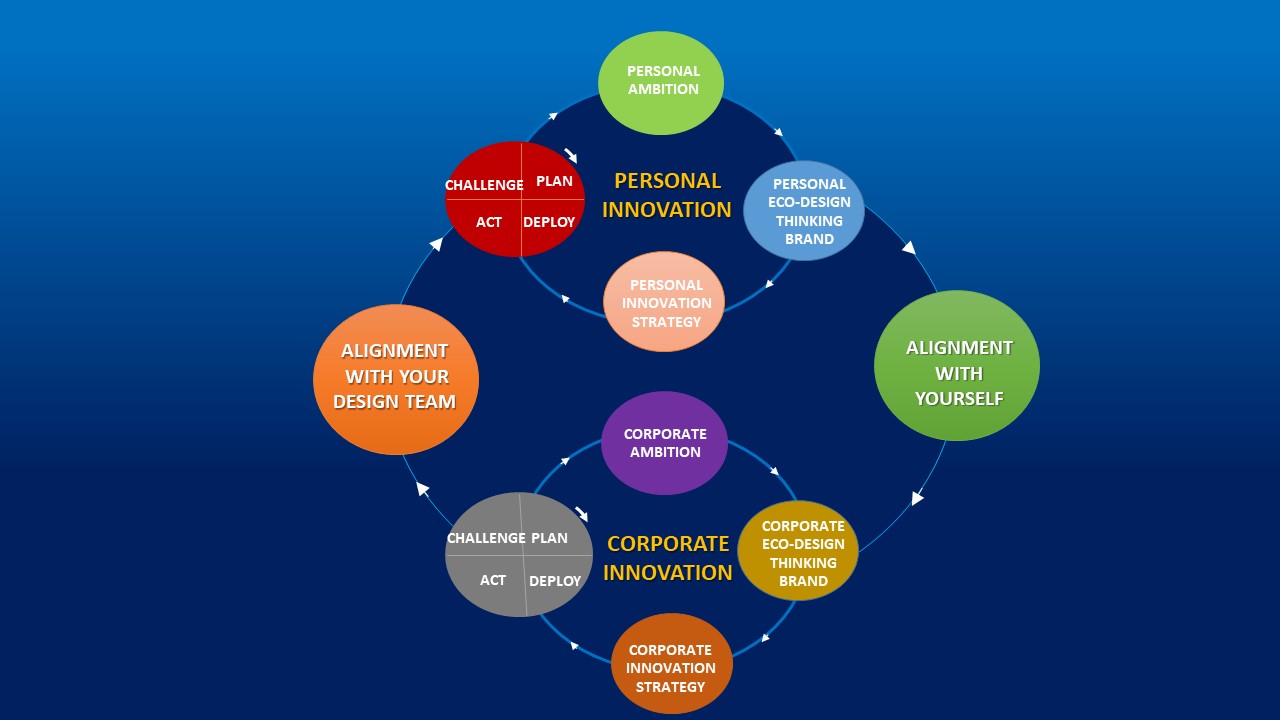
Personal innovation, corporate innovation, personal integrity, empathy, and designer engagement all play a role in the larger picture. You can learn more about these topics by reading my article “Aligning Personal Innovation with Corporate Innovation.”
Here are some benefits of the new eco-design thinking model:
- Before delving into design issues, exploring and redesigning your own life is essential. This approach leads to more intelligent and innovative designs and better use of generative AI, resulting in better designs.
- The use of generative AI in the initial stage of the design process promotes a culture of personal disruptive innovation, creating unique and empathetic designs.
- A high level of personal integrity and designer’s empathy is necessary to achieve superior design quality.
- Before starting to build your product or service, creating a thoughtful and innovative design that considers empathy is possible. This approach can lead to faster design implementation.
- Design performance is enhanced while design throughput time is shortened, all thanks to the innovative and happy designers constantly learning as a team. This ultimately leads to an improvement in the overall quality of the designs.
- By gradually building and enhancing the product or process and detecting defects early on, you can achieve faster design outcomes.
- By utilizing generative AI and compelling storytelling, you can obtain more reliable user feedback. This can be achieved by implementing a personal eco-design thinking branding blueprint, improving design quality.
If you utilize this new design model, you can transform into a thriving eco-design thinker, as illustrated in the table below.
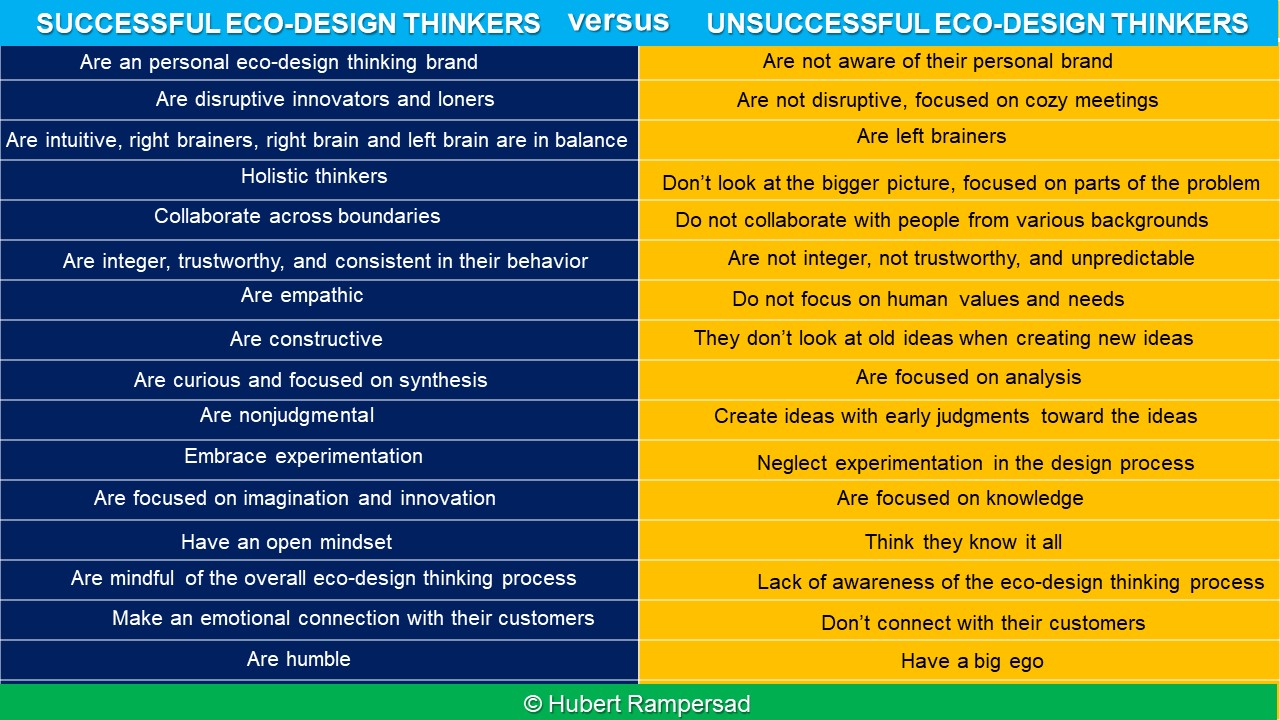
Various traditional design tools can be accessed online.
There are numerous traditional design tools accessible online for each phase of the design process. For instance, consider Hasso Plattner Institute of Design at Stanford University, IDEO, Designkit, Designorate, University of Virginia, InVisionApp, Board of Innovation, and Pinterest. This article introduces a visionary and sustainable design perspective rather than discussing design tools like many competitors.
Introducing the Eco-Design Thinking Tool Kit, which provides support for the Eco-Design Model
Additional design tools have been incorporated to aid and streamline the implementation of the new Eco-Design Thinking approach. These tools have been aligned with the model to boost its efficiency:
- Personal Disruptive Innovation Methodology; for innovative ideas and more imaginative designs.
- Generative AI tools like Midjourney, ChatGPT, and Stable Diffusion.
- Personal Innovation Strategy; to become more innovative and intelligent.
- Personal Eco-Design Thinking Branding System; to enhance storytelling and empathy.
- Breathing and Silence Exercise; to enhance imagination.
- Personal Integrity Methodology; to exhibit empathic behavior effectively and become a better human being.
- Eco-Design Thinking Code of Ethics; for ethical designs that foster empathy.
- Designer’s Alignment and Engagement in the Design Team; to achieve better performance from the design team, it is essential to ensure that the designer is happy and engaged first, as this will ultimately lead to a better experience for the end user.
What other components are necessary for designing a better world?
To create a sustainable and better world, it is important to take into account other factors apart from what I have discussed in this article. However, I have already covered these topics in my related articles:
- Sustainable Leadership; read “The Future of Leadership.”
- Sustainable Corporate Governance; read “The Future of Corporate Governance,” Eco-Design Thinking Code of Ethics, and “How to Cultivate Personal Integrity.”
- Sustainable Diversity & Inclusion; read “Eco-Diversity.”
- Sustainable HR; read “Changing the Role of HR.”
If you’re interested in gaining more knowledge about this subject, you may want to consider attending his free live webinar: How Generative AI Helps Design a Better World
If you’re interested in gaining more knowledge about this subject, you may want to consider attending his related master class.
—————————————————————————————–
Here is some early praise for his book“Eco-Design Thinking for Personal, Corporate, and Social Innovation.”
Hubert Rampersad, Ph.D., is a visionary leader in innovative solutions for genuine sustainability, disruptive design innovation, critical thinking in the age of AI, authentic personal branding, and entrepreneurial leadership. He holds a Ph.D. in Innovation Sciences, an MSc in Technology Engineering & Robotics, and a BSc in Mechanical Engineering from leading accredited universities in the Netherlands/Europe (Delft University of Technology, Eindhoven University of Technology). He is a well-known futurist, advocating for genuine sustainability on a global scale. With extensive knowledge and expertise, he has authored 25 books on the topics above in many languages and is highly regarded for his insights in these fields. One of his books, “Total Performance Scorecard,” has been published in 20 languages. Dorothy Leonard, an innovation professor at Harvard Business School, wrote the book’s foreword. Rampersad has also previously served as a guest lecturer at MIT Sloan and was featured in BusinessWeek. He was a design innovation coach at ASML (the Most Important Tech Company in the World).
Orlando, Florida | tpsi@live.com | Phone/whatsapp: +13053992116|
About the author https://bit.ly/2CQLIfS








